LB5230: Managing Strategic Resources and Operations of Toyota Report
VerifiedAdded on 2022/08/19
|9
|2853
|352
Report
AI Summary
This report provides a comprehensive analysis of Toyota's supply chain management, focusing on its strategic resources and operations. It begins with an overview of Toyota, highlighting its global presence and manufacturing processes. The report then delves into Toyota's supply chain management, explaining its lean manufacturing system (TPS), and the flow of information, materials, and money. It examines the relationships with suppliers, procurement, manufacturing processes, distribution, and dealer networks. The report also links Toyota's activities with relevant theories of supply chain management, including primary activities like inbound logistics, operations, outbound logistics, and service, as well as supporting activities such as firm infrastructure, human resource management, and technology development. Furthermore, it explores the company's value chain sustainability, emphasizing its commitment to corporate social responsibility (CSR) and sustainable practices. The report concludes by highlighting Toyota's success in the automobile industry, attributing it to the efficient use of supply chain management, achieving a competitive advantage, and maintaining a strong market reputation.
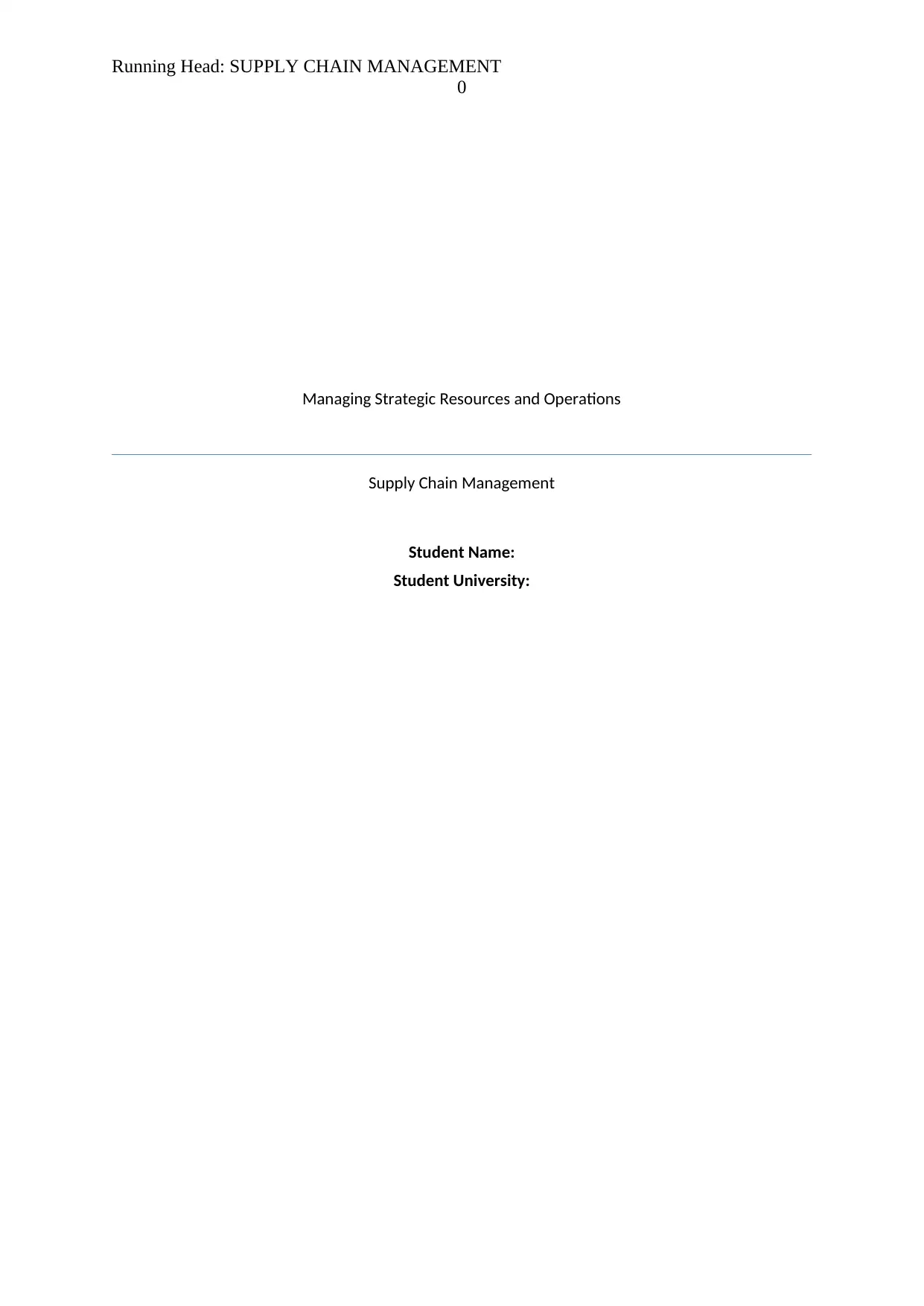
Running Head: SUPPLY CHAIN MANAGEMENT
0
Managing Strategic Resources and Operations
Supply Chain Management
Student Name:
Student University:
0
Managing Strategic Resources and Operations
Supply Chain Management
Student Name:
Student University:
Paraphrase This Document
Need a fresh take? Get an instant paraphrase of this document with our AI Paraphraser
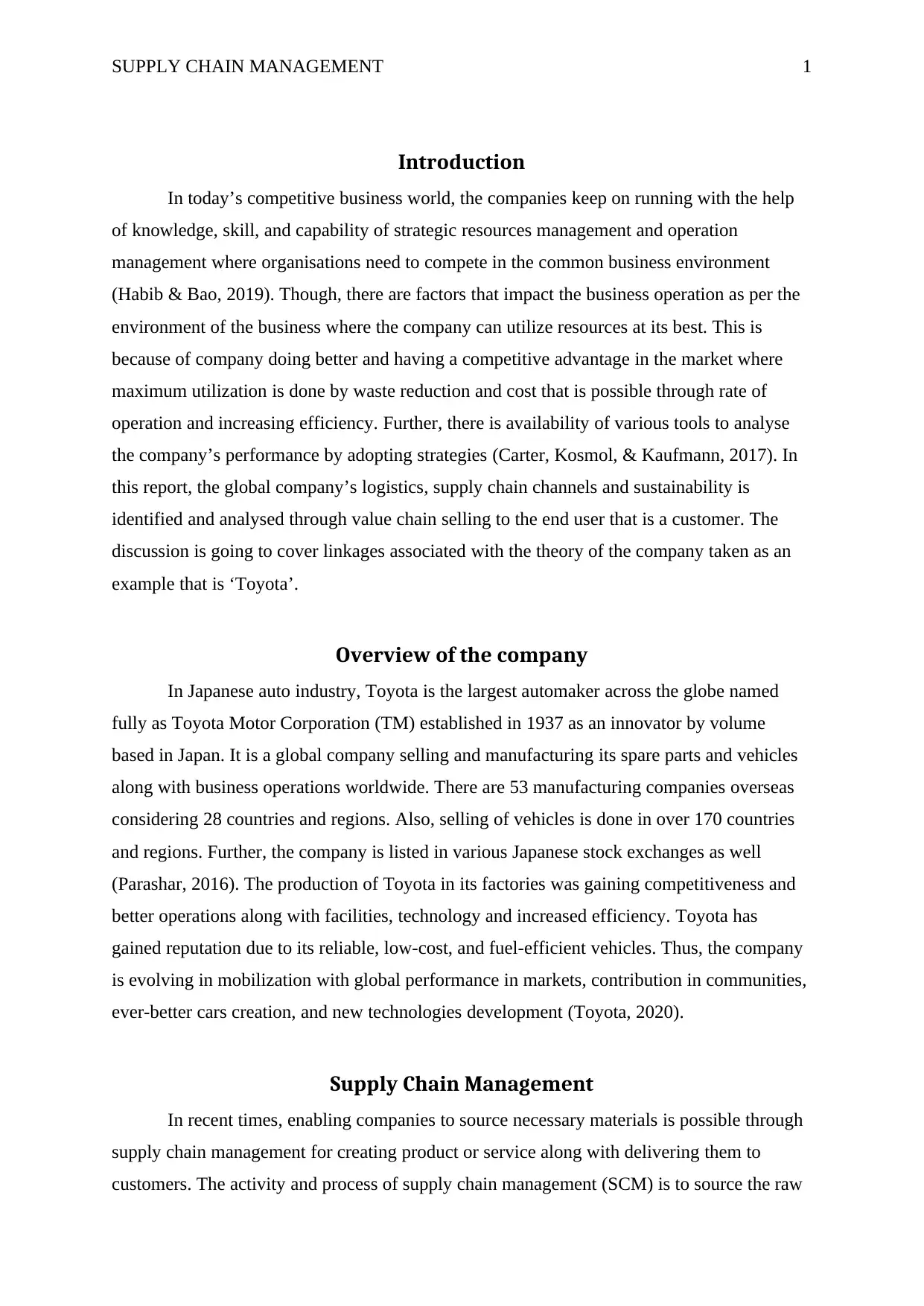
SUPPLY CHAIN MANAGEMENT 1
Introduction
In today’s competitive business world, the companies keep on running with the help
of knowledge, skill, and capability of strategic resources management and operation
management where organisations need to compete in the common business environment
(Habib & Bao, 2019). Though, there are factors that impact the business operation as per the
environment of the business where the company can utilize resources at its best. This is
because of company doing better and having a competitive advantage in the market where
maximum utilization is done by waste reduction and cost that is possible through rate of
operation and increasing efficiency. Further, there is availability of various tools to analyse
the company’s performance by adopting strategies (Carter, Kosmol, & Kaufmann, 2017). In
this report, the global company’s logistics, supply chain channels and sustainability is
identified and analysed through value chain selling to the end user that is a customer. The
discussion is going to cover linkages associated with the theory of the company taken as an
example that is ‘Toyota’.
Overview of the company
In Japanese auto industry, Toyota is the largest automaker across the globe named
fully as Toyota Motor Corporation (TM) established in 1937 as an innovator by volume
based in Japan. It is a global company selling and manufacturing its spare parts and vehicles
along with business operations worldwide. There are 53 manufacturing companies overseas
considering 28 countries and regions. Also, selling of vehicles is done in over 170 countries
and regions. Further, the company is listed in various Japanese stock exchanges as well
(Parashar, 2016). The production of Toyota in its factories was gaining competitiveness and
better operations along with facilities, technology and increased efficiency. Toyota has
gained reputation due to its reliable, low-cost, and fuel-efficient vehicles. Thus, the company
is evolving in mobilization with global performance in markets, contribution in communities,
ever-better cars creation, and new technologies development (Toyota, 2020).
Supply Chain Management
In recent times, enabling companies to source necessary materials is possible through
supply chain management for creating product or service along with delivering them to
customers. The activity and process of supply chain management (SCM) is to source the raw
Introduction
In today’s competitive business world, the companies keep on running with the help
of knowledge, skill, and capability of strategic resources management and operation
management where organisations need to compete in the common business environment
(Habib & Bao, 2019). Though, there are factors that impact the business operation as per the
environment of the business where the company can utilize resources at its best. This is
because of company doing better and having a competitive advantage in the market where
maximum utilization is done by waste reduction and cost that is possible through rate of
operation and increasing efficiency. Further, there is availability of various tools to analyse
the company’s performance by adopting strategies (Carter, Kosmol, & Kaufmann, 2017). In
this report, the global company’s logistics, supply chain channels and sustainability is
identified and analysed through value chain selling to the end user that is a customer. The
discussion is going to cover linkages associated with the theory of the company taken as an
example that is ‘Toyota’.
Overview of the company
In Japanese auto industry, Toyota is the largest automaker across the globe named
fully as Toyota Motor Corporation (TM) established in 1937 as an innovator by volume
based in Japan. It is a global company selling and manufacturing its spare parts and vehicles
along with business operations worldwide. There are 53 manufacturing companies overseas
considering 28 countries and regions. Also, selling of vehicles is done in over 170 countries
and regions. Further, the company is listed in various Japanese stock exchanges as well
(Parashar, 2016). The production of Toyota in its factories was gaining competitiveness and
better operations along with facilities, technology and increased efficiency. Toyota has
gained reputation due to its reliable, low-cost, and fuel-efficient vehicles. Thus, the company
is evolving in mobilization with global performance in markets, contribution in communities,
ever-better cars creation, and new technologies development (Toyota, 2020).
Supply Chain Management
In recent times, enabling companies to source necessary materials is possible through
supply chain management for creating product or service along with delivering them to
customers. The activity and process of supply chain management (SCM) is to source the raw
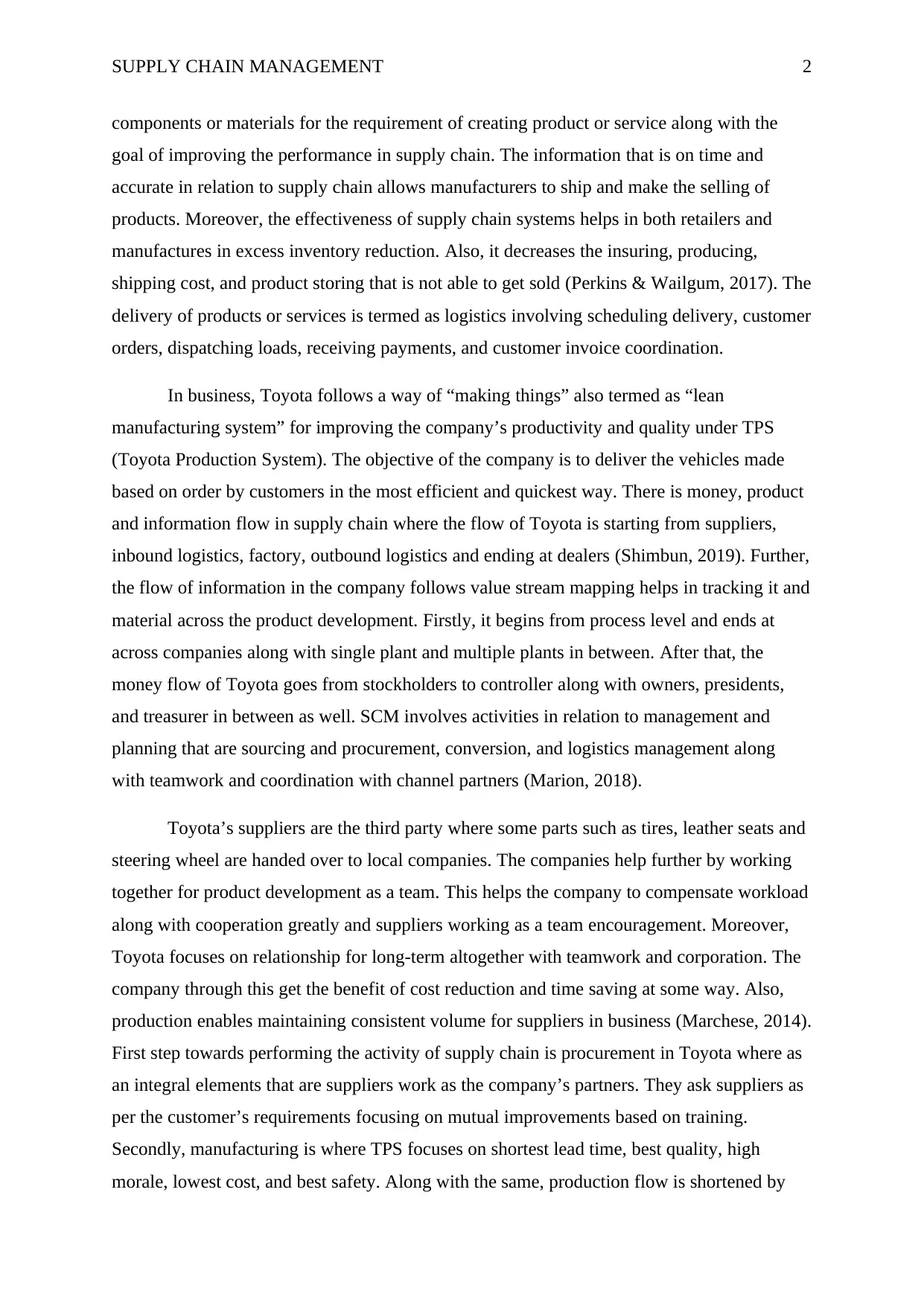
SUPPLY CHAIN MANAGEMENT 2
components or materials for the requirement of creating product or service along with the
goal of improving the performance in supply chain. The information that is on time and
accurate in relation to supply chain allows manufacturers to ship and make the selling of
products. Moreover, the effectiveness of supply chain systems helps in both retailers and
manufactures in excess inventory reduction. Also, it decreases the insuring, producing,
shipping cost, and product storing that is not able to get sold (Perkins & Wailgum, 2017). The
delivery of products or services is termed as logistics involving scheduling delivery, customer
orders, dispatching loads, receiving payments, and customer invoice coordination.
In business, Toyota follows a way of “making things” also termed as “lean
manufacturing system” for improving the company’s productivity and quality under TPS
(Toyota Production System). The objective of the company is to deliver the vehicles made
based on order by customers in the most efficient and quickest way. There is money, product
and information flow in supply chain where the flow of Toyota is starting from suppliers,
inbound logistics, factory, outbound logistics and ending at dealers (Shimbun, 2019). Further,
the flow of information in the company follows value stream mapping helps in tracking it and
material across the product development. Firstly, it begins from process level and ends at
across companies along with single plant and multiple plants in between. After that, the
money flow of Toyota goes from stockholders to controller along with owners, presidents,
and treasurer in between as well. SCM involves activities in relation to management and
planning that are sourcing and procurement, conversion, and logistics management along
with teamwork and coordination with channel partners (Marion, 2018).
Toyota’s suppliers are the third party where some parts such as tires, leather seats and
steering wheel are handed over to local companies. The companies help further by working
together for product development as a team. This helps the company to compensate workload
along with cooperation greatly and suppliers working as a team encouragement. Moreover,
Toyota focuses on relationship for long-term altogether with teamwork and corporation. The
company through this get the benefit of cost reduction and time saving at some way. Also,
production enables maintaining consistent volume for suppliers in business (Marchese, 2014).
First step towards performing the activity of supply chain is procurement in Toyota where as
an integral elements that are suppliers work as the company’s partners. They ask suppliers as
per the customer’s requirements focusing on mutual improvements based on training.
Secondly, manufacturing is where TPS focuses on shortest lead time, best quality, high
morale, lowest cost, and best safety. Along with the same, production flow is shortened by
components or materials for the requirement of creating product or service along with the
goal of improving the performance in supply chain. The information that is on time and
accurate in relation to supply chain allows manufacturers to ship and make the selling of
products. Moreover, the effectiveness of supply chain systems helps in both retailers and
manufactures in excess inventory reduction. Also, it decreases the insuring, producing,
shipping cost, and product storing that is not able to get sold (Perkins & Wailgum, 2017). The
delivery of products or services is termed as logistics involving scheduling delivery, customer
orders, dispatching loads, receiving payments, and customer invoice coordination.
In business, Toyota follows a way of “making things” also termed as “lean
manufacturing system” for improving the company’s productivity and quality under TPS
(Toyota Production System). The objective of the company is to deliver the vehicles made
based on order by customers in the most efficient and quickest way. There is money, product
and information flow in supply chain where the flow of Toyota is starting from suppliers,
inbound logistics, factory, outbound logistics and ending at dealers (Shimbun, 2019). Further,
the flow of information in the company follows value stream mapping helps in tracking it and
material across the product development. Firstly, it begins from process level and ends at
across companies along with single plant and multiple plants in between. After that, the
money flow of Toyota goes from stockholders to controller along with owners, presidents,
and treasurer in between as well. SCM involves activities in relation to management and
planning that are sourcing and procurement, conversion, and logistics management along
with teamwork and coordination with channel partners (Marion, 2018).
Toyota’s suppliers are the third party where some parts such as tires, leather seats and
steering wheel are handed over to local companies. The companies help further by working
together for product development as a team. This helps the company to compensate workload
along with cooperation greatly and suppliers working as a team encouragement. Moreover,
Toyota focuses on relationship for long-term altogether with teamwork and corporation. The
company through this get the benefit of cost reduction and time saving at some way. Also,
production enables maintaining consistent volume for suppliers in business (Marchese, 2014).
First step towards performing the activity of supply chain is procurement in Toyota where as
an integral elements that are suppliers work as the company’s partners. They ask suppliers as
per the customer’s requirements focusing on mutual improvements based on training.
Secondly, manufacturing is where TPS focuses on shortest lead time, best quality, high
morale, lowest cost, and best safety. Along with the same, production flow is shortened by
⊘ This is a preview!⊘
Do you want full access?
Subscribe today to unlock all pages.

Trusted by 1+ million students worldwide
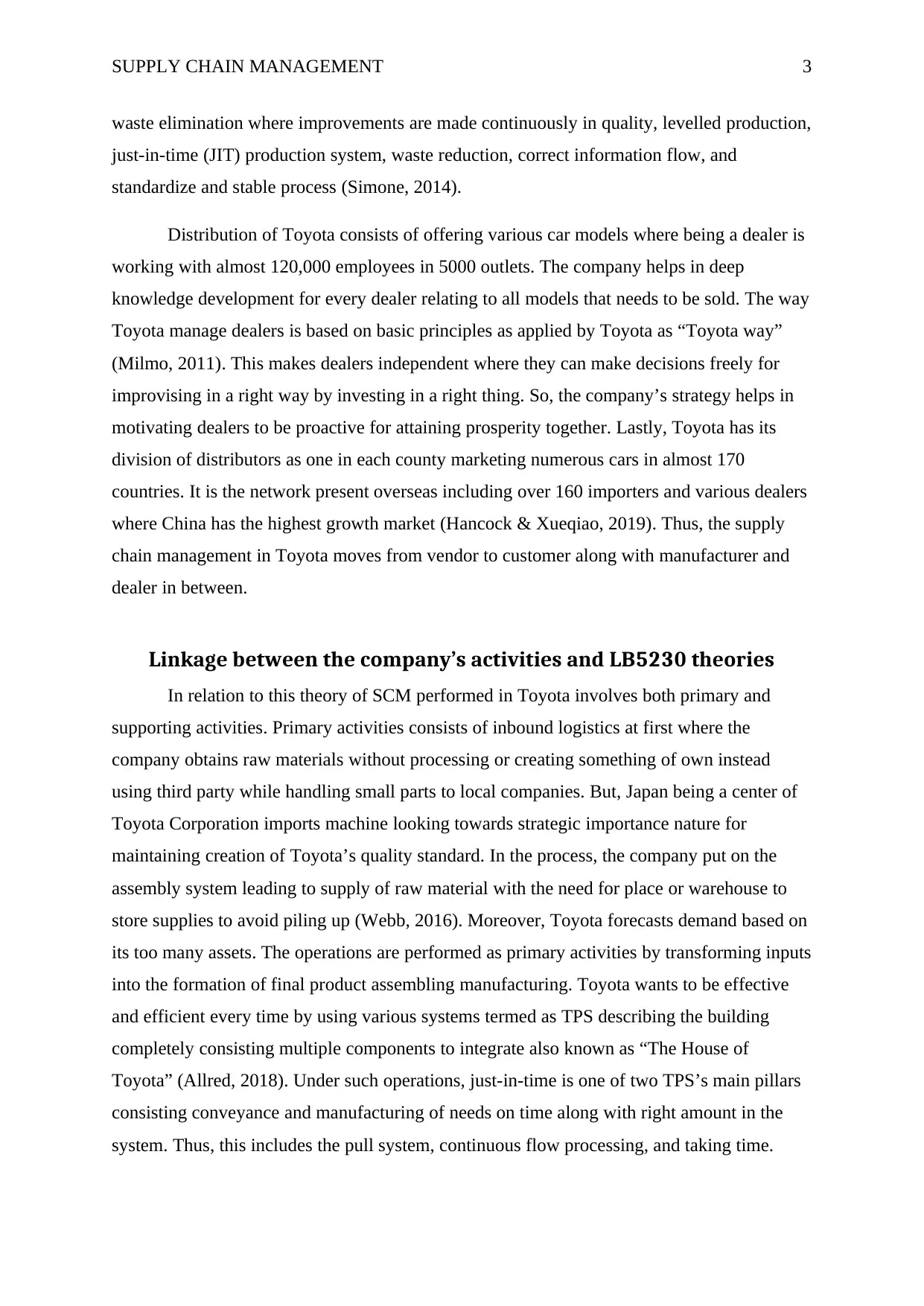
SUPPLY CHAIN MANAGEMENT 3
waste elimination where improvements are made continuously in quality, levelled production,
just-in-time (JIT) production system, waste reduction, correct information flow, and
standardize and stable process (Simone, 2014).
Distribution of Toyota consists of offering various car models where being a dealer is
working with almost 120,000 employees in 5000 outlets. The company helps in deep
knowledge development for every dealer relating to all models that needs to be sold. The way
Toyota manage dealers is based on basic principles as applied by Toyota as “Toyota way”
(Milmo, 2011). This makes dealers independent where they can make decisions freely for
improvising in a right way by investing in a right thing. So, the company’s strategy helps in
motivating dealers to be proactive for attaining prosperity together. Lastly, Toyota has its
division of distributors as one in each county marketing numerous cars in almost 170
countries. It is the network present overseas including over 160 importers and various dealers
where China has the highest growth market (Hancock & Xueqiao, 2019). Thus, the supply
chain management in Toyota moves from vendor to customer along with manufacturer and
dealer in between.
Linkage between the company’s activities and LB5230 theories
In relation to this theory of SCM performed in Toyota involves both primary and
supporting activities. Primary activities consists of inbound logistics at first where the
company obtains raw materials without processing or creating something of own instead
using third party while handling small parts to local companies. But, Japan being a center of
Toyota Corporation imports machine looking towards strategic importance nature for
maintaining creation of Toyota’s quality standard. In the process, the company put on the
assembly system leading to supply of raw material with the need for place or warehouse to
store supplies to avoid piling up (Webb, 2016). Moreover, Toyota forecasts demand based on
its too many assets. The operations are performed as primary activities by transforming inputs
into the formation of final product assembling manufacturing. Toyota wants to be effective
and efficient every time by using various systems termed as TPS describing the building
completely consisting multiple components to integrate also known as “The House of
Toyota” (Allred, 2018). Under such operations, just-in-time is one of two TPS’s main pillars
consisting conveyance and manufacturing of needs on time along with right amount in the
system. Thus, this includes the pull system, continuous flow processing, and taking time.
waste elimination where improvements are made continuously in quality, levelled production,
just-in-time (JIT) production system, waste reduction, correct information flow, and
standardize and stable process (Simone, 2014).
Distribution of Toyota consists of offering various car models where being a dealer is
working with almost 120,000 employees in 5000 outlets. The company helps in deep
knowledge development for every dealer relating to all models that needs to be sold. The way
Toyota manage dealers is based on basic principles as applied by Toyota as “Toyota way”
(Milmo, 2011). This makes dealers independent where they can make decisions freely for
improvising in a right way by investing in a right thing. So, the company’s strategy helps in
motivating dealers to be proactive for attaining prosperity together. Lastly, Toyota has its
division of distributors as one in each county marketing numerous cars in almost 170
countries. It is the network present overseas including over 160 importers and various dealers
where China has the highest growth market (Hancock & Xueqiao, 2019). Thus, the supply
chain management in Toyota moves from vendor to customer along with manufacturer and
dealer in between.
Linkage between the company’s activities and LB5230 theories
In relation to this theory of SCM performed in Toyota involves both primary and
supporting activities. Primary activities consists of inbound logistics at first where the
company obtains raw materials without processing or creating something of own instead
using third party while handling small parts to local companies. But, Japan being a center of
Toyota Corporation imports machine looking towards strategic importance nature for
maintaining creation of Toyota’s quality standard. In the process, the company put on the
assembly system leading to supply of raw material with the need for place or warehouse to
store supplies to avoid piling up (Webb, 2016). Moreover, Toyota forecasts demand based on
its too many assets. The operations are performed as primary activities by transforming inputs
into the formation of final product assembling manufacturing. Toyota wants to be effective
and efficient every time by using various systems termed as TPS describing the building
completely consisting multiple components to integrate also known as “The House of
Toyota” (Allred, 2018). Under such operations, just-in-time is one of two TPS’s main pillars
consisting conveyance and manufacturing of needs on time along with right amount in the
system. Thus, this includes the pull system, continuous flow processing, and taking time.
Paraphrase This Document
Need a fresh take? Get an instant paraphrase of this document with our AI Paraphraser
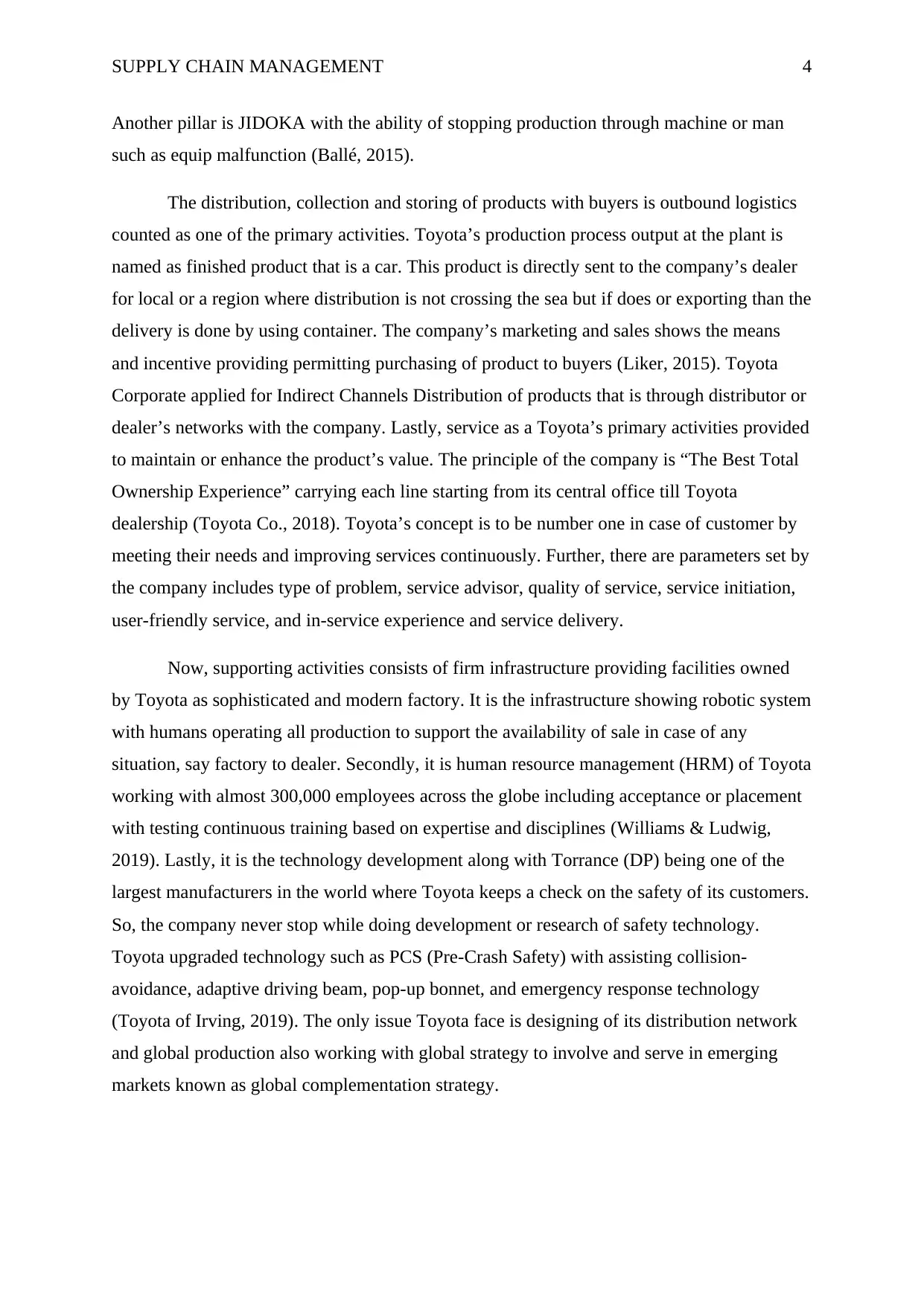
SUPPLY CHAIN MANAGEMENT 4
Another pillar is JIDOKA with the ability of stopping production through machine or man
such as equip malfunction (Ballé, 2015).
The distribution, collection and storing of products with buyers is outbound logistics
counted as one of the primary activities. Toyota’s production process output at the plant is
named as finished product that is a car. This product is directly sent to the company’s dealer
for local or a region where distribution is not crossing the sea but if does or exporting than the
delivery is done by using container. The company’s marketing and sales shows the means
and incentive providing permitting purchasing of product to buyers (Liker, 2015). Toyota
Corporate applied for Indirect Channels Distribution of products that is through distributor or
dealer’s networks with the company. Lastly, service as a Toyota’s primary activities provided
to maintain or enhance the product’s value. The principle of the company is “The Best Total
Ownership Experience” carrying each line starting from its central office till Toyota
dealership (Toyota Co., 2018). Toyota’s concept is to be number one in case of customer by
meeting their needs and improving services continuously. Further, there are parameters set by
the company includes type of problem, service advisor, quality of service, service initiation,
user-friendly service, and in-service experience and service delivery.
Now, supporting activities consists of firm infrastructure providing facilities owned
by Toyota as sophisticated and modern factory. It is the infrastructure showing robotic system
with humans operating all production to support the availability of sale in case of any
situation, say factory to dealer. Secondly, it is human resource management (HRM) of Toyota
working with almost 300,000 employees across the globe including acceptance or placement
with testing continuous training based on expertise and disciplines (Williams & Ludwig,
2019). Lastly, it is the technology development along with Torrance (DP) being one of the
largest manufacturers in the world where Toyota keeps a check on the safety of its customers.
So, the company never stop while doing development or research of safety technology.
Toyota upgraded technology such as PCS (Pre-Crash Safety) with assisting collision-
avoidance, adaptive driving beam, pop-up bonnet, and emergency response technology
(Toyota of Irving, 2019). The only issue Toyota face is designing of its distribution network
and global production also working with global strategy to involve and serve in emerging
markets known as global complementation strategy.
Another pillar is JIDOKA with the ability of stopping production through machine or man
such as equip malfunction (Ballé, 2015).
The distribution, collection and storing of products with buyers is outbound logistics
counted as one of the primary activities. Toyota’s production process output at the plant is
named as finished product that is a car. This product is directly sent to the company’s dealer
for local or a region where distribution is not crossing the sea but if does or exporting than the
delivery is done by using container. The company’s marketing and sales shows the means
and incentive providing permitting purchasing of product to buyers (Liker, 2015). Toyota
Corporate applied for Indirect Channels Distribution of products that is through distributor or
dealer’s networks with the company. Lastly, service as a Toyota’s primary activities provided
to maintain or enhance the product’s value. The principle of the company is “The Best Total
Ownership Experience” carrying each line starting from its central office till Toyota
dealership (Toyota Co., 2018). Toyota’s concept is to be number one in case of customer by
meeting their needs and improving services continuously. Further, there are parameters set by
the company includes type of problem, service advisor, quality of service, service initiation,
user-friendly service, and in-service experience and service delivery.
Now, supporting activities consists of firm infrastructure providing facilities owned
by Toyota as sophisticated and modern factory. It is the infrastructure showing robotic system
with humans operating all production to support the availability of sale in case of any
situation, say factory to dealer. Secondly, it is human resource management (HRM) of Toyota
working with almost 300,000 employees across the globe including acceptance or placement
with testing continuous training based on expertise and disciplines (Williams & Ludwig,
2019). Lastly, it is the technology development along with Torrance (DP) being one of the
largest manufacturers in the world where Toyota keeps a check on the safety of its customers.
So, the company never stop while doing development or research of safety technology.
Toyota upgraded technology such as PCS (Pre-Crash Safety) with assisting collision-
avoidance, adaptive driving beam, pop-up bonnet, and emergency response technology
(Toyota of Irving, 2019). The only issue Toyota face is designing of its distribution network
and global production also working with global strategy to involve and serve in emerging
markets known as global complementation strategy.
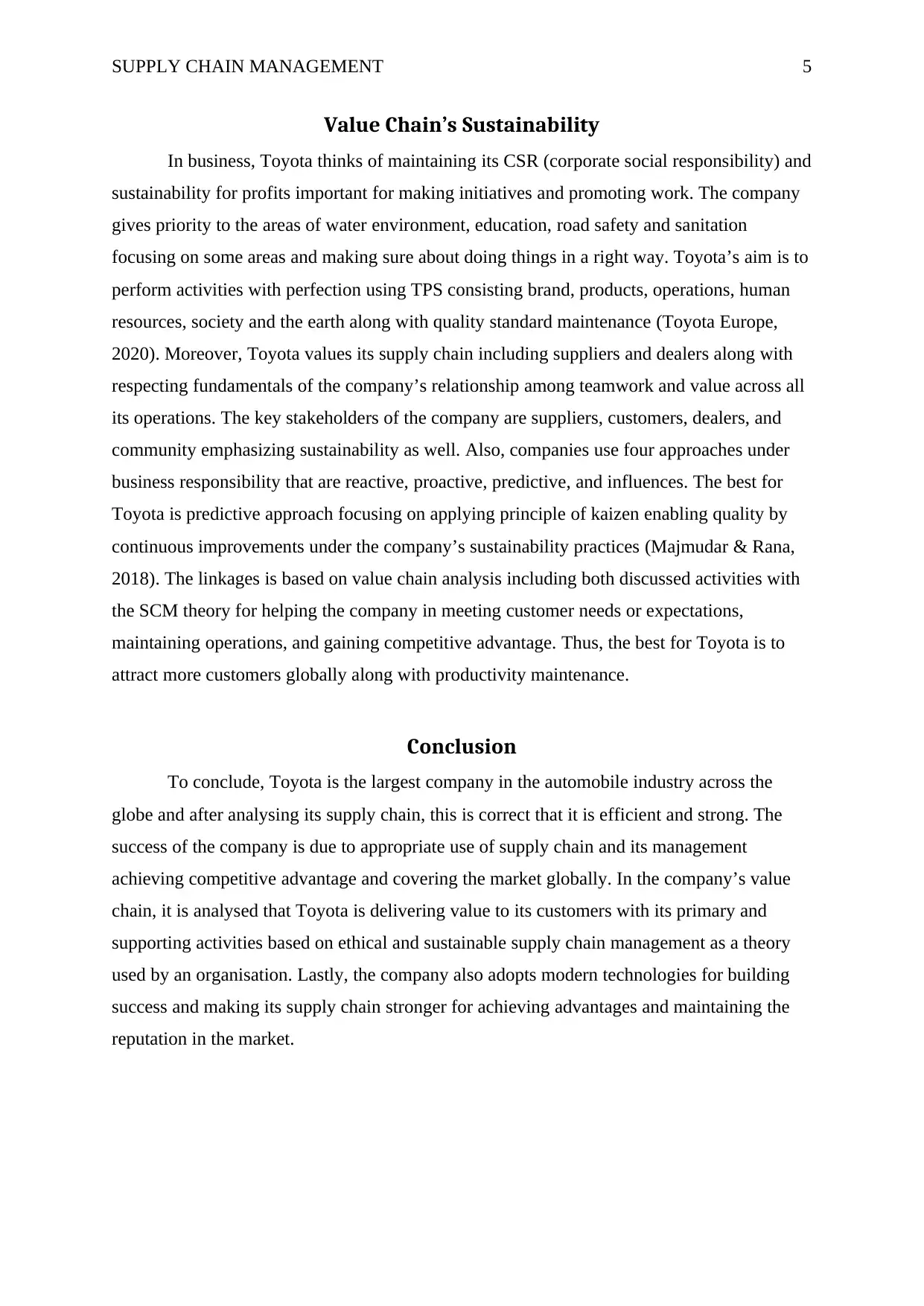
SUPPLY CHAIN MANAGEMENT 5
Value Chain’s Sustainability
In business, Toyota thinks of maintaining its CSR (corporate social responsibility) and
sustainability for profits important for making initiatives and promoting work. The company
gives priority to the areas of water environment, education, road safety and sanitation
focusing on some areas and making sure about doing things in a right way. Toyota’s aim is to
perform activities with perfection using TPS consisting brand, products, operations, human
resources, society and the earth along with quality standard maintenance (Toyota Europe,
2020). Moreover, Toyota values its supply chain including suppliers and dealers along with
respecting fundamentals of the company’s relationship among teamwork and value across all
its operations. The key stakeholders of the company are suppliers, customers, dealers, and
community emphasizing sustainability as well. Also, companies use four approaches under
business responsibility that are reactive, proactive, predictive, and influences. The best for
Toyota is predictive approach focusing on applying principle of kaizen enabling quality by
continuous improvements under the company’s sustainability practices (Majmudar & Rana,
2018). The linkages is based on value chain analysis including both discussed activities with
the SCM theory for helping the company in meeting customer needs or expectations,
maintaining operations, and gaining competitive advantage. Thus, the best for Toyota is to
attract more customers globally along with productivity maintenance.
Conclusion
To conclude, Toyota is the largest company in the automobile industry across the
globe and after analysing its supply chain, this is correct that it is efficient and strong. The
success of the company is due to appropriate use of supply chain and its management
achieving competitive advantage and covering the market globally. In the company’s value
chain, it is analysed that Toyota is delivering value to its customers with its primary and
supporting activities based on ethical and sustainable supply chain management as a theory
used by an organisation. Lastly, the company also adopts modern technologies for building
success and making its supply chain stronger for achieving advantages and maintaining the
reputation in the market.
Value Chain’s Sustainability
In business, Toyota thinks of maintaining its CSR (corporate social responsibility) and
sustainability for profits important for making initiatives and promoting work. The company
gives priority to the areas of water environment, education, road safety and sanitation
focusing on some areas and making sure about doing things in a right way. Toyota’s aim is to
perform activities with perfection using TPS consisting brand, products, operations, human
resources, society and the earth along with quality standard maintenance (Toyota Europe,
2020). Moreover, Toyota values its supply chain including suppliers and dealers along with
respecting fundamentals of the company’s relationship among teamwork and value across all
its operations. The key stakeholders of the company are suppliers, customers, dealers, and
community emphasizing sustainability as well. Also, companies use four approaches under
business responsibility that are reactive, proactive, predictive, and influences. The best for
Toyota is predictive approach focusing on applying principle of kaizen enabling quality by
continuous improvements under the company’s sustainability practices (Majmudar & Rana,
2018). The linkages is based on value chain analysis including both discussed activities with
the SCM theory for helping the company in meeting customer needs or expectations,
maintaining operations, and gaining competitive advantage. Thus, the best for Toyota is to
attract more customers globally along with productivity maintenance.
Conclusion
To conclude, Toyota is the largest company in the automobile industry across the
globe and after analysing its supply chain, this is correct that it is efficient and strong. The
success of the company is due to appropriate use of supply chain and its management
achieving competitive advantage and covering the market globally. In the company’s value
chain, it is analysed that Toyota is delivering value to its customers with its primary and
supporting activities based on ethical and sustainable supply chain management as a theory
used by an organisation. Lastly, the company also adopts modern technologies for building
success and making its supply chain stronger for achieving advantages and maintaining the
reputation in the market.
⊘ This is a preview!⊘
Do you want full access?
Subscribe today to unlock all pages.

Trusted by 1+ million students worldwide
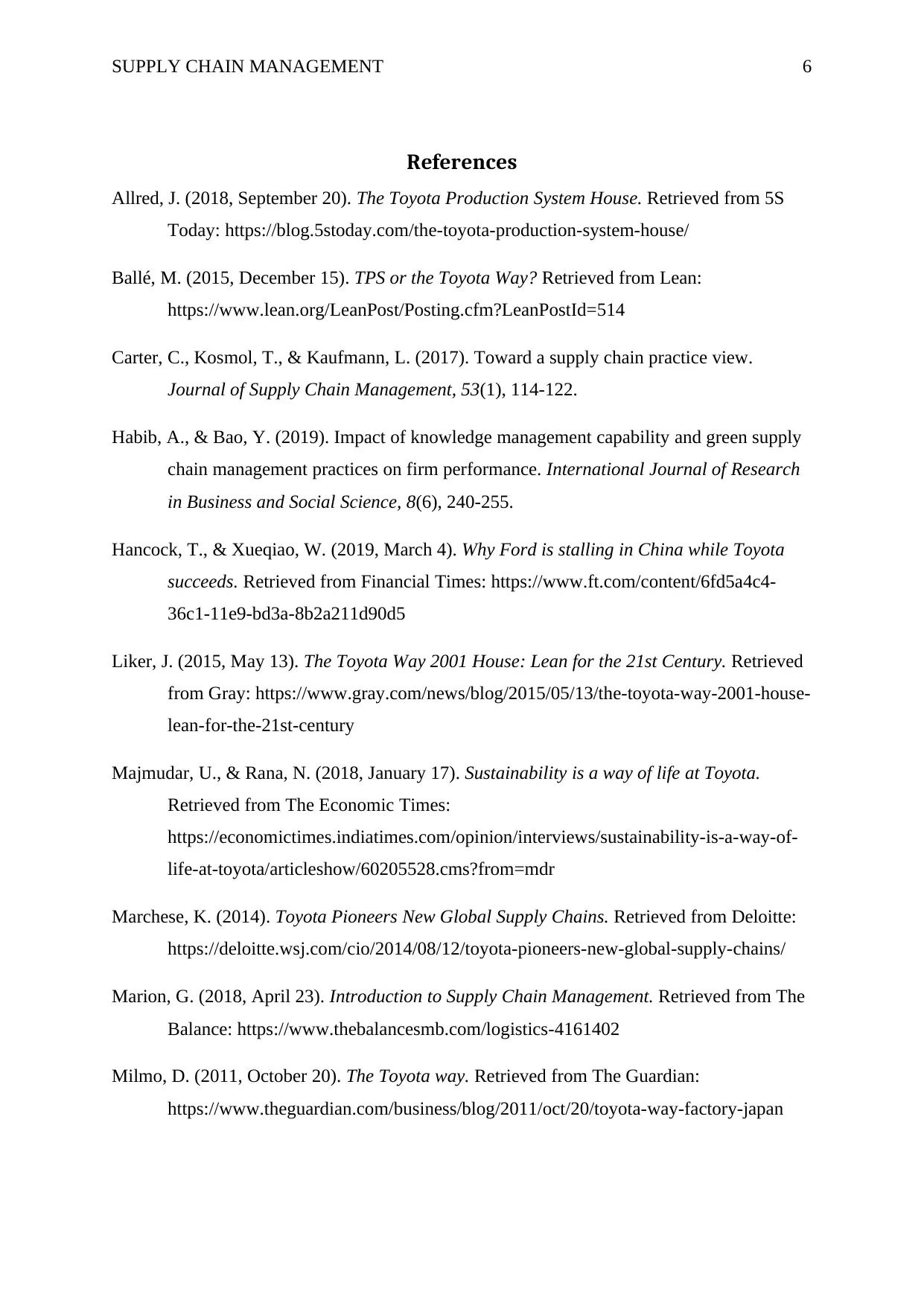
SUPPLY CHAIN MANAGEMENT 6
References
Allred, J. (2018, September 20). The Toyota Production System House. Retrieved from 5S
Today: https://blog.5stoday.com/the-toyota-production-system-house/
Ballé, M. (2015, December 15). TPS or the Toyota Way? Retrieved from Lean:
https://www.lean.org/LeanPost/Posting.cfm?LeanPostId=514
Carter, C., Kosmol, T., & Kaufmann, L. (2017). Toward a supply chain practice view.
Journal of Supply Chain Management, 53(1), 114-122.
Habib, A., & Bao, Y. (2019). Impact of knowledge management capability and green supply
chain management practices on firm performance. International Journal of Research
in Business and Social Science, 8(6), 240-255.
Hancock, T., & Xueqiao, W. (2019, March 4). Why Ford is stalling in China while Toyota
succeeds. Retrieved from Financial Times: https://www.ft.com/content/6fd5a4c4-
36c1-11e9-bd3a-8b2a211d90d5
Liker, J. (2015, May 13). The Toyota Way 2001 House: Lean for the 21st Century. Retrieved
from Gray: https://www.gray.com/news/blog/2015/05/13/the-toyota-way-2001-house-
lean-for-the-21st-century
Majmudar, U., & Rana, N. (2018, January 17). Sustainability is a way of life at Toyota.
Retrieved from The Economic Times:
https://economictimes.indiatimes.com/opinion/interviews/sustainability-is-a-way-of-
life-at-toyota/articleshow/60205528.cms?from=mdr
Marchese, K. (2014). Toyota Pioneers New Global Supply Chains. Retrieved from Deloitte:
https://deloitte.wsj.com/cio/2014/08/12/toyota-pioneers-new-global-supply-chains/
Marion, G. (2018, April 23). Introduction to Supply Chain Management. Retrieved from The
Balance: https://www.thebalancesmb.com/logistics-4161402
Milmo, D. (2011, October 20). The Toyota way. Retrieved from The Guardian:
https://www.theguardian.com/business/blog/2011/oct/20/toyota-way-factory-japan
References
Allred, J. (2018, September 20). The Toyota Production System House. Retrieved from 5S
Today: https://blog.5stoday.com/the-toyota-production-system-house/
Ballé, M. (2015, December 15). TPS or the Toyota Way? Retrieved from Lean:
https://www.lean.org/LeanPost/Posting.cfm?LeanPostId=514
Carter, C., Kosmol, T., & Kaufmann, L. (2017). Toward a supply chain practice view.
Journal of Supply Chain Management, 53(1), 114-122.
Habib, A., & Bao, Y. (2019). Impact of knowledge management capability and green supply
chain management practices on firm performance. International Journal of Research
in Business and Social Science, 8(6), 240-255.
Hancock, T., & Xueqiao, W. (2019, March 4). Why Ford is stalling in China while Toyota
succeeds. Retrieved from Financial Times: https://www.ft.com/content/6fd5a4c4-
36c1-11e9-bd3a-8b2a211d90d5
Liker, J. (2015, May 13). The Toyota Way 2001 House: Lean for the 21st Century. Retrieved
from Gray: https://www.gray.com/news/blog/2015/05/13/the-toyota-way-2001-house-
lean-for-the-21st-century
Majmudar, U., & Rana, N. (2018, January 17). Sustainability is a way of life at Toyota.
Retrieved from The Economic Times:
https://economictimes.indiatimes.com/opinion/interviews/sustainability-is-a-way-of-
life-at-toyota/articleshow/60205528.cms?from=mdr
Marchese, K. (2014). Toyota Pioneers New Global Supply Chains. Retrieved from Deloitte:
https://deloitte.wsj.com/cio/2014/08/12/toyota-pioneers-new-global-supply-chains/
Marion, G. (2018, April 23). Introduction to Supply Chain Management. Retrieved from The
Balance: https://www.thebalancesmb.com/logistics-4161402
Milmo, D. (2011, October 20). The Toyota way. Retrieved from The Guardian:
https://www.theguardian.com/business/blog/2011/oct/20/toyota-way-factory-japan
Paraphrase This Document
Need a fresh take? Get an instant paraphrase of this document with our AI Paraphraser
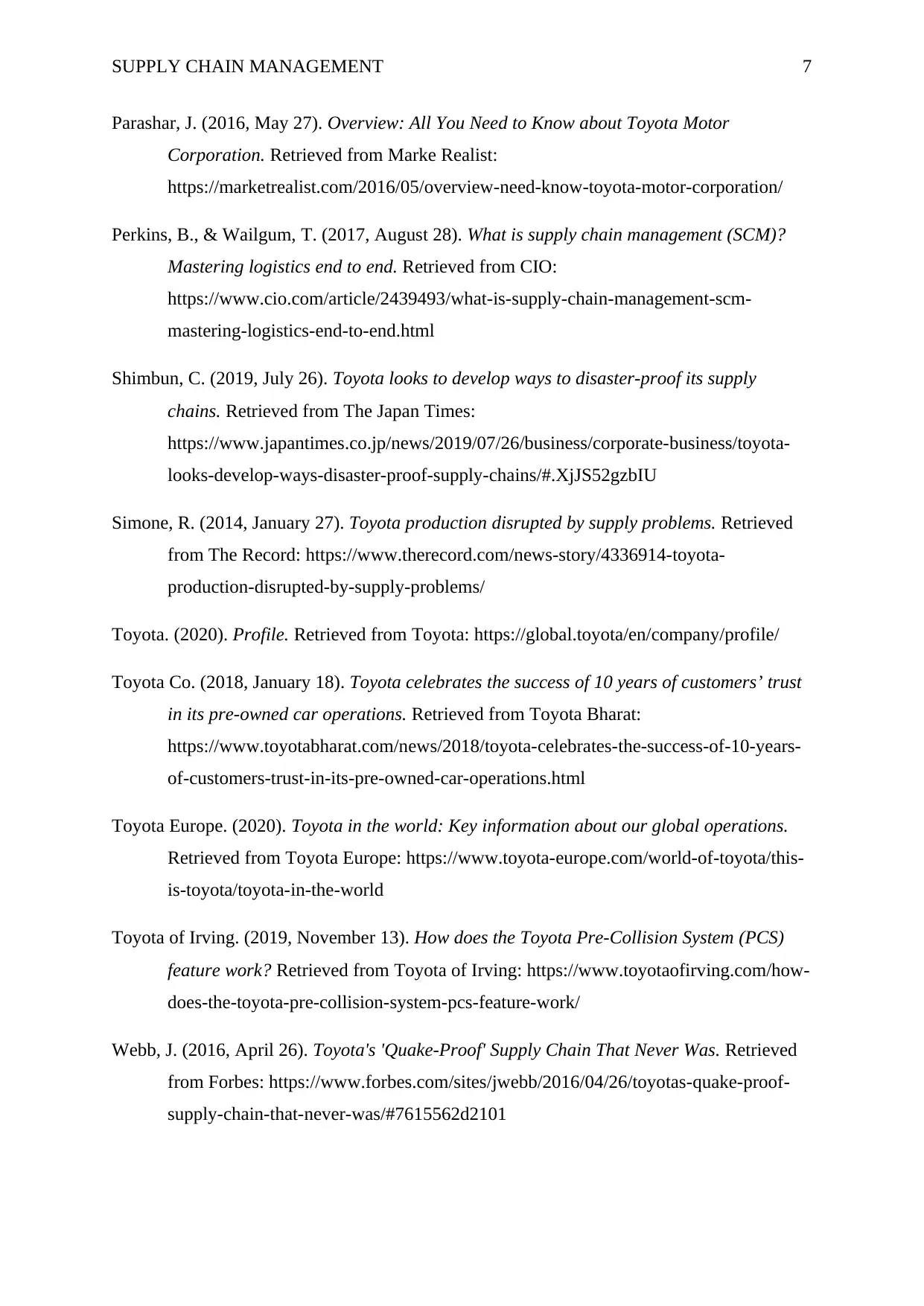
SUPPLY CHAIN MANAGEMENT 7
Parashar, J. (2016, May 27). Overview: All You Need to Know about Toyota Motor
Corporation. Retrieved from Marke Realist:
https://marketrealist.com/2016/05/overview-need-know-toyota-motor-corporation/
Perkins, B., & Wailgum, T. (2017, August 28). What is supply chain management (SCM)?
Mastering logistics end to end. Retrieved from CIO:
https://www.cio.com/article/2439493/what-is-supply-chain-management-scm-
mastering-logistics-end-to-end.html
Shimbun, C. (2019, July 26). Toyota looks to develop ways to disaster-proof its supply
chains. Retrieved from The Japan Times:
https://www.japantimes.co.jp/news/2019/07/26/business/corporate-business/toyota-
looks-develop-ways-disaster-proof-supply-chains/#.XjJS52gzbIU
Simone, R. (2014, January 27). Toyota production disrupted by supply problems. Retrieved
from The Record: https://www.therecord.com/news-story/4336914-toyota-
production-disrupted-by-supply-problems/
Toyota. (2020). Profile. Retrieved from Toyota: https://global.toyota/en/company/profile/
Toyota Co. (2018, January 18). Toyota celebrates the success of 10 years of customers’ trust
in its pre-owned car operations. Retrieved from Toyota Bharat:
https://www.toyotabharat.com/news/2018/toyota-celebrates-the-success-of-10-years-
of-customers-trust-in-its-pre-owned-car-operations.html
Toyota Europe. (2020). Toyota in the world: Key information about our global operations.
Retrieved from Toyota Europe: https://www.toyota-europe.com/world-of-toyota/this-
is-toyota/toyota-in-the-world
Toyota of Irving. (2019, November 13). How does the Toyota Pre-Collision System (PCS)
feature work? Retrieved from Toyota of Irving: https://www.toyotaofirving.com/how-
does-the-toyota-pre-collision-system-pcs-feature-work/
Webb, J. (2016, April 26). Toyota's 'Quake-Proof' Supply Chain That Never Was. Retrieved
from Forbes: https://www.forbes.com/sites/jwebb/2016/04/26/toyotas-quake-proof-
supply-chain-that-never-was/#7615562d2101
Parashar, J. (2016, May 27). Overview: All You Need to Know about Toyota Motor
Corporation. Retrieved from Marke Realist:
https://marketrealist.com/2016/05/overview-need-know-toyota-motor-corporation/
Perkins, B., & Wailgum, T. (2017, August 28). What is supply chain management (SCM)?
Mastering logistics end to end. Retrieved from CIO:
https://www.cio.com/article/2439493/what-is-supply-chain-management-scm-
mastering-logistics-end-to-end.html
Shimbun, C. (2019, July 26). Toyota looks to develop ways to disaster-proof its supply
chains. Retrieved from The Japan Times:
https://www.japantimes.co.jp/news/2019/07/26/business/corporate-business/toyota-
looks-develop-ways-disaster-proof-supply-chains/#.XjJS52gzbIU
Simone, R. (2014, January 27). Toyota production disrupted by supply problems. Retrieved
from The Record: https://www.therecord.com/news-story/4336914-toyota-
production-disrupted-by-supply-problems/
Toyota. (2020). Profile. Retrieved from Toyota: https://global.toyota/en/company/profile/
Toyota Co. (2018, January 18). Toyota celebrates the success of 10 years of customers’ trust
in its pre-owned car operations. Retrieved from Toyota Bharat:
https://www.toyotabharat.com/news/2018/toyota-celebrates-the-success-of-10-years-
of-customers-trust-in-its-pre-owned-car-operations.html
Toyota Europe. (2020). Toyota in the world: Key information about our global operations.
Retrieved from Toyota Europe: https://www.toyota-europe.com/world-of-toyota/this-
is-toyota/toyota-in-the-world
Toyota of Irving. (2019, November 13). How does the Toyota Pre-Collision System (PCS)
feature work? Retrieved from Toyota of Irving: https://www.toyotaofirving.com/how-
does-the-toyota-pre-collision-system-pcs-feature-work/
Webb, J. (2016, April 26). Toyota's 'Quake-Proof' Supply Chain That Never Was. Retrieved
from Forbes: https://www.forbes.com/sites/jwebb/2016/04/26/toyotas-quake-proof-
supply-chain-that-never-was/#7615562d2101
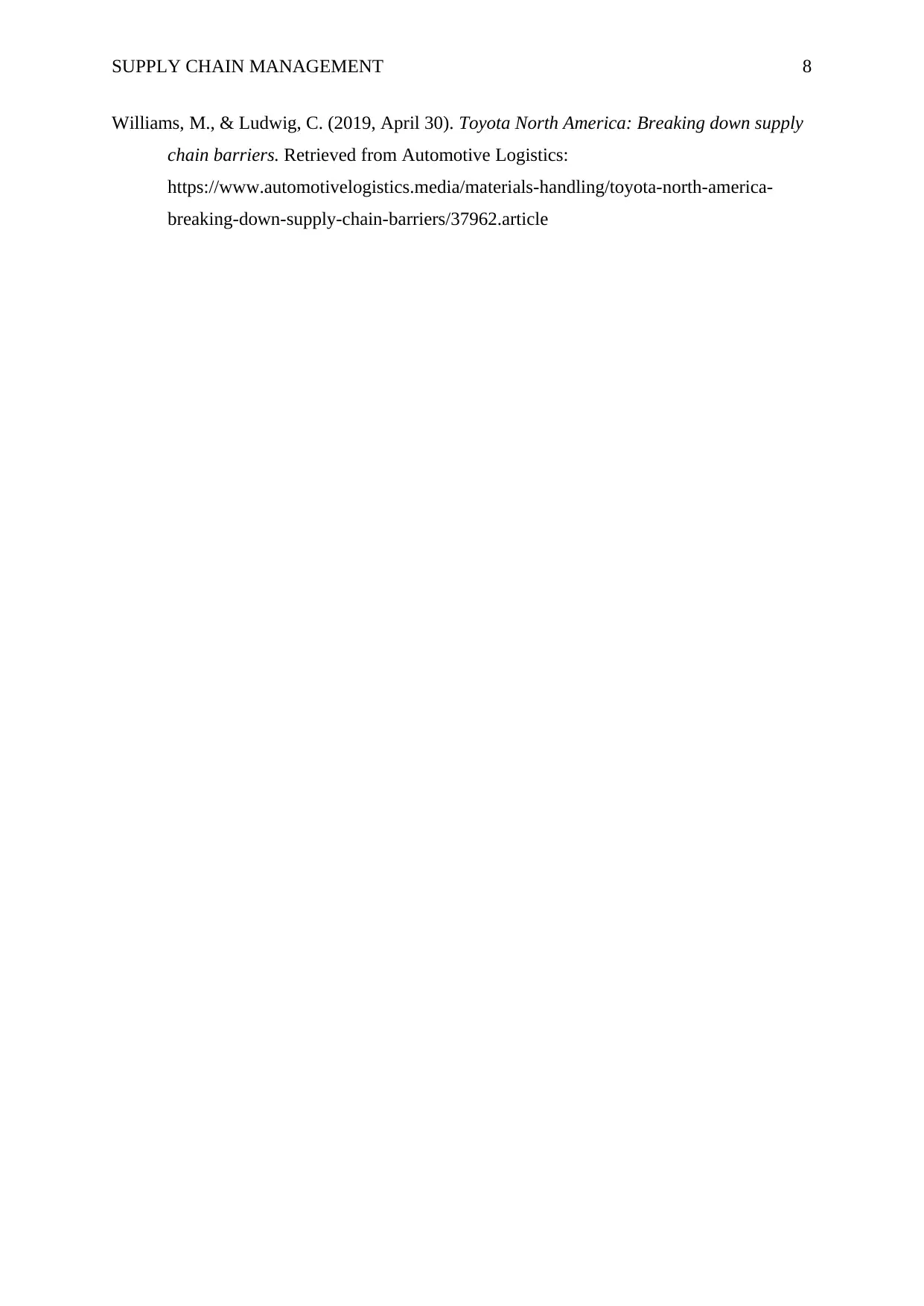
SUPPLY CHAIN MANAGEMENT 8
Williams, M., & Ludwig, C. (2019, April 30). Toyota North America: Breaking down supply
chain barriers. Retrieved from Automotive Logistics:
https://www.automotivelogistics.media/materials-handling/toyota-north-america-
breaking-down-supply-chain-barriers/37962.article
Williams, M., & Ludwig, C. (2019, April 30). Toyota North America: Breaking down supply
chain barriers. Retrieved from Automotive Logistics:
https://www.automotivelogistics.media/materials-handling/toyota-north-america-
breaking-down-supply-chain-barriers/37962.article
⊘ This is a preview!⊘
Do you want full access?
Subscribe today to unlock all pages.

Trusted by 1+ million students worldwide
1 out of 9
Related Documents
Your All-in-One AI-Powered Toolkit for Academic Success.
+13062052269
info@desklib.com
Available 24*7 on WhatsApp / Email
![[object Object]](/_next/static/media/star-bottom.7253800d.svg)
Unlock your academic potential
Copyright © 2020–2025 A2Z Services. All Rights Reserved. Developed and managed by ZUCOL.





